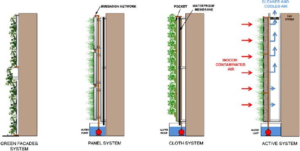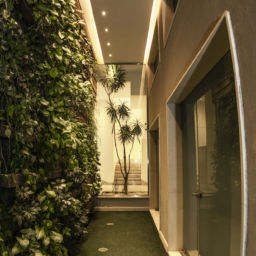
When we mention Green Walls, we mention as well the cities that were surrounded by vast stretches of rural areas. Nowadays, the rural population is decreasing while the urban population is constantly increasing, which leads to the rapid expansion of cities. This massive urban development is altering the Earth’s surface by concentrating materials that effectively keep heat and create impervious surfaces, thus affecting the urban microclimate and urban hydrology.
Tall buildings provide multiple surfaces to absorb solar radiation which is later re-radiated as heat, enhancing the efficiency with which urban areas are heated.
This associated with wasted heat from energy use, leads to increased temperatures in cities known as the urban heat island (UHI) effect, a precursor to other problems ranging from human health issues to high energy consumption because of the overuse of air conditioner systems. Urban areas are major concentrates and emitters of multiple pollutants resulting from human activities within the built environment. Besides these issues, other environmental and ecological problems arise because of unsustainable urban development.
As a result, new building strategies and methods are needed to reduce the adverse environmental impacts of urban infrastructures while improving their social and economic value. Urban greening initiatives are a way to achieve environmental goals while minimizing the undesirable effects of urban growth. However, the development and expansion of cities has traditionally been guided by the criterion of maximizing built area to increase profitability.
What is the Vertical Green Walls System?
Green Wall systems are also known as Vertical Garden systems. They comprise vertical structures that spread vegetation that may or may not be attached to a building facade or an interior wall. Given the level of complexity, there are many green wall patterns that range from the simplest configuration to the most complex and high-tech design. Depending on the type of vegetation and the supporting structures used, According to Maria Manso and João P. Castro-Gomes in their published paper at Renewable and Sustainable Energy Reviews Journal, these systems can be divided into two major groups: green facades and living walls.
In green facade systems, vegetation is formed by climbing plants or successive ground cover. Specially designed structures can force the development of the plant through the wall of the building, which can serve as a support for climbing plants. Typically, green fronts are rooted at the base in the ground or in plant boxes, but intermediate planters, mounted on a wall at a certain height or even on rooftops, can also be used as a fallen green sequence. Because of the lower diversity and density of plants, green facades usually require less intensive maintenance and protection than living walls. Having said that they also need a lot more time to achieve the green exterior look and are usually less impressive from an aesthetic point of view when compared to living walls.
Living walls are more complex infrastructures that include a supporting structure with different connecting methods. A waterproof backing is required to isolate the living wall from the building to avoid moisture related problems. An irrigation network is also essential while fertilization, monitoring and lighting systems are optional.

Source: Burritt, K. (2013). Survey of Suitable Plants for Cal Poly’s Green Wall.
Cloth System and Panel System
Cloth and panels are the most commonly used methods of attaching vegetation to a supporting structure. Inside the panel system, there is the possibility of planting on site once the structure is attached to the wall or using pre-planted panels prior to planting in custom-built structures. In each of these cases, the growth medium is allocated within the pocket (if a cloth system is used) or the plate. Systems that use organic or inorganic growing media along with mineral nutrients to grow plants outside the soil are also known as soilless or hydroponic systems.
In some particular formations, the plants do not take root on the growing media, but the roots are directly attached to the canvas, becoming a unique hydroponic system based on irrigation reliability.
What are the Benefits of Green Wall Systems?
Researchers are increasingly aware of the potential and positive effects that urban greening initiatives play on many aspects of the urban environment. Over the past 25 years, the scientific community has made many efforts to shed light on the multiple ecological, ecological, and social benefits of green roof systems. This interest has extended over recent years to vertical green wall systems to provide responses and more knowledge about their characteristics compared to other urban green infrastructures. Perez and Fernandez in their study entitled “Vertical Greening Systems and Sustainable Cities”, review the special benefits of vertical green wall systems, focusing on their environmental, ecological and social impacts.
1- Ecological Benefits
Urban areas show, in most cases, less biodiversity than the pre-urban ecosystem. The need to conserve biodiversity for the continuation of our species and the fact that land designated for protected areas does not prevent biodiversity loss has led to the development of new ecological concepts and methods for conserving Earth’s biodiversity.
In this context, conciliation ecology aims to modify and diversify human habitats to support a greater range of species without compromising land use. Vertical green wall systems, as well as green roofs, are a good example of the practice of matchmaking, as these infrastructures create habitats for plants and animals on the land that are directly used by humans as living space.
They enhance urban biodiversity and thus the urban environment by allowing spontaneous vegetation to colonize these systems. Because they can mimic natural vertical habitats such as cliffs or plant waterfalls, they provide habitats for birds and insects responsible for many functions and ecosystem services, such as pollination or biological control. They can also be used to grow species that can address specific functions that are missing in the urban environment, mostly directed at plants’ ability to remove air pollutants.
2– Environmental Benefits
Using plants to improve the quality of the surrounding environment has become a major design consideration in modern building development processes that seek not only an aesthetic effect but also a means of providing environmental services, such as natural air cooling, water purification, and mitigation from several environmental problems.
With indoor living walls, the indoor environment of a building may benefit from the positive effects reported by plants on air quality, which relate not only to the plants’ ability to adhesion molecules from the air but also to their efficiency (along with microorganisms present in the substrate) in absorbing air pollutants.
In the latter process, known as biological filtration, carbon dioxide (CO2) and harmful toxins are retained by both the plants and the substrate as air is drawn in through the living wall. In an experiment Done by Ross Cameron and Jane Taylor with these bio-filters, indoor air concentrations for three systems with noxious vertical green walls (toluene, ethylbenzene, and oxylene) were significantly reduced when air was forced to pass through vegetation.
Besides mitigating air pollution, air temperature and humidity are other key variables of indoor air quality, and are largely related to human comfort, which may be altered by indoor living walls. In warm climates, temperature drops of up to 4-8 °C are observed in the areas around the inner living wall.
When installed on the exterior walls of buildings, it has been reported that living walls have an important impact on the thermal performance of buildings and on the urban environment. Given that plants absorb an extensive amount of solar radiation for their growth and biological functions, such as respiration, transpiration and photosynthesis, vertical green wall systems could also play an important role in shaping the urban microclimate.
3- Social Benefits
Using vertical green walls is also a highly impactful way to transform the urban landscape, integrating advanced materials and technology to promote sustainable building functions. Creative architectural solutions that implement elements of green spaces either for the restoration of old buildings or in the design of new buildings will certainly improve the aesthetic aspect of our cities.
For example, White and Gatersleben conducted a study to evaluate the aesthetic impact and the level of perceived restoration that could be achieved by placing green roofs and facades on homes. The results of the study showed that houses with integrated vegetation were more preferred and considered more beautiful, aesthetically pleasing and restorative than those without vegetation.
There are some “perceived benefits” of these greening initiatives. Sometimes, it provides a place for recreation and retreat where people can enjoy quiet moments amidst a dense urban setting. As another example, the service sector offers more environmentally conscious products and services, so these systems provide added environmental and aesthetic value that are highly valued by existing customers. In addition, there is an increasing level of social awareness of the benefits of promoting local green initiatives within urban communities that such systems can gain positive acceptance in densely populated cities. Indeed, the social component can be enhanced when these technologies are incorporated into the pool of ‘green’ options within urban greening movements.
The number of initiatives that have successfully implemented the use of new urban greening concepts within urban communities is increasing. Even though green roofs have been the most widespread of these technologies, living walls are increasing in popularity all around the world and especially in the Middle East and we can expect to see more of them in commercial as well as residential spaces in the next decade.
Be Part of the Green Initiative for a Promising Green and Sustainable Future.
At Schaduf we created our first-generation Green Wall system in 2011. Since then, Schaduf has executed over 100 projects, installed over 7,000 square meters and planted over a quarter of a million plants in Egypt and the Middle East.
Whether you are a business owner, an aspiring young architect or an experienced interior designer, you can now add a new concept of the work environment to your designs to improve the wellbeing of employees and users of any space. Order the Green Wall now from the expert house in the Middle East.














